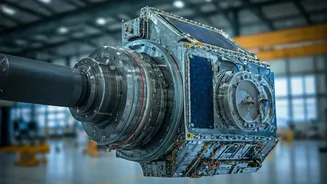ISS Retirement Announced
NASA's decision to retire the International Space Station (ISS) by the end of 2030 marks a significant juncture in space exploration. The ISS, a collaborative
project involving several international space agencies, has been continuously inhabited for over two decades. However, its operational costs and the emergence of new technological capabilities have prompted NASA to look toward new strategies. Decommissioning the ISS will involve a controlled re-entry into Earth's atmosphere, ensuring that any remaining debris safely burns up during the process. This controlled descent is crucial to minimize any potential risk to populated areas, thereby adhering to safety protocols in the process. The transition signifies a change in NASA's approach to space exploration, which is indicative of a move towards supporting the commercial space industry.
Transitioning to Private Stations
The shift away from the ISS is fueled by a desire for efficiency and innovation. Private companies are rapidly developing space stations, potentially offering more advanced and cost-effective platforms for research and exploration. NASA plans to facilitate this transition by leveraging commercial space stations, fostering partnerships that could help reduce costs and promote technological development. These private stations are designed to offer a flexible range of capabilities, from conducting scientific experiments to providing commercial services, all while enhancing space exploration efforts. Moreover, NASA's strategy includes supporting various initiatives and collaborations, so as to ensure a smooth transition, thereby maintaining a continuous presence in low Earth orbit. Through this approach, NASA seeks to maximize the benefits of private-sector involvement, thereby driving innovation and extending the frontiers of space exploration.
Benefits of the Shift
The move to commercial space stations has multiple benefits. Primarily, it should allow NASA to focus on deep-space exploration, such as missions to the Moon and Mars, as the agency will be able to depend on commercial companies for services in low Earth orbit. This division of labor will allow NASA to specialize in more complex missions, thus enhancing the overall scope of space exploration. Secondly, the private sector's involvement is likely to encourage competition and innovation. Companies that invest in space stations are driven by commercial objectives, leading to advanced technologies and operational efficiencies. Thirdly, the adoption of commercial stations helps lower costs. The private sector's efficiency and streamlined operations, coupled with the potential for multiple revenue streams, allow them to provide services at competitive prices. Finally, the ability to support diverse space research and technology demonstrations, as well as providing more advanced platforms, is a key benefit.
Challenges Ahead
Even though this transition looks promising, it comes with many challenges. One of the main challenges is to ensure the safety and reliability of the new commercial space stations. Stringent safety standards and rigorous testing will be crucial to guarantee the well-being of astronauts and the integrity of missions. Another major challenge is financial sustainability. NASA must provide the correct financial support to commercial space station providers to ensure that these facilities remain operational. This involves developing sustainable funding models that can support long-term commercial operations. Establishing clear regulatory frameworks and coordinating activities among different entities can also be challenging. It is important to promote a collaborative approach. Moreover, the integration of new technologies and systems requires extensive testing and validation to minimize risks and ensure seamless integration with existing systems. It will also be important to ensure data security and interoperability across different platforms to facilitate research and collaboration.
Future Implications
The transition to private space stations will have several significant implications for space exploration. It will reshape how space missions are conducted, promoting collaboration between government agencies and commercial entities. This integration of the private sector will likely spur technological innovation, thereby leading to advancements in areas such as propulsion, life support systems, and materials science. Furthermore, this shift could open up new opportunities for commercial activities in space, including space tourism, in-space manufacturing, and resource extraction. The long-term objective of this strategy is to facilitate a sustainable and vibrant space economy. Therefore, the future of space exploration will be shaped by public-private partnerships, technological innovation, and expanding commercial opportunities, making it a pivotal time in the history of space exploration and an exciting prospect for the generations to come.










